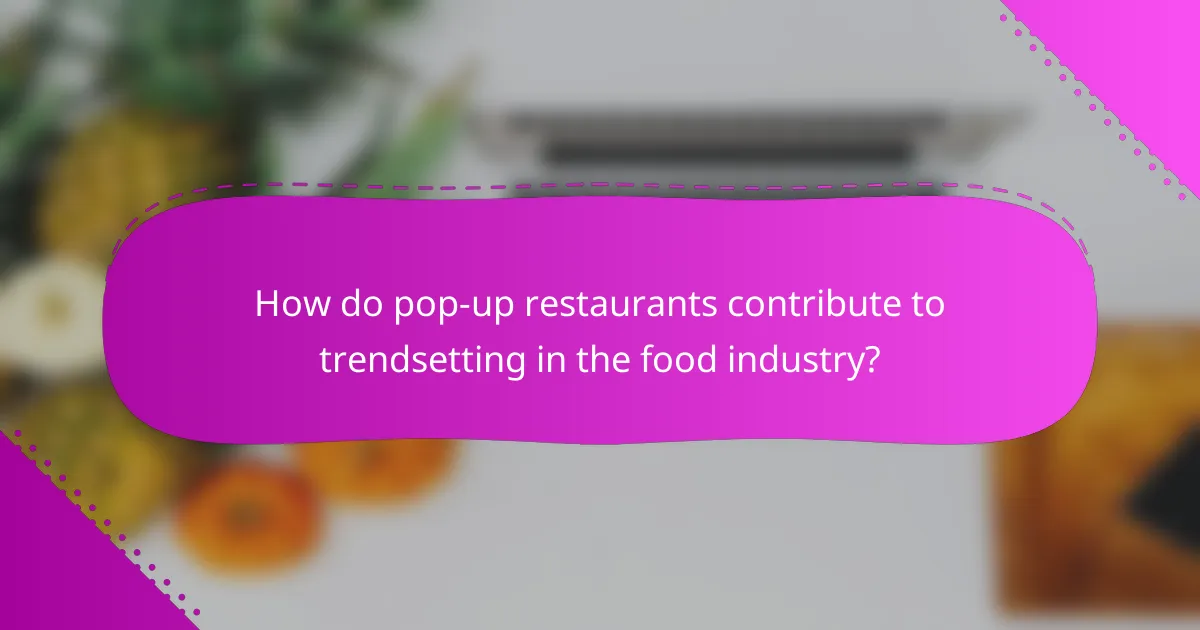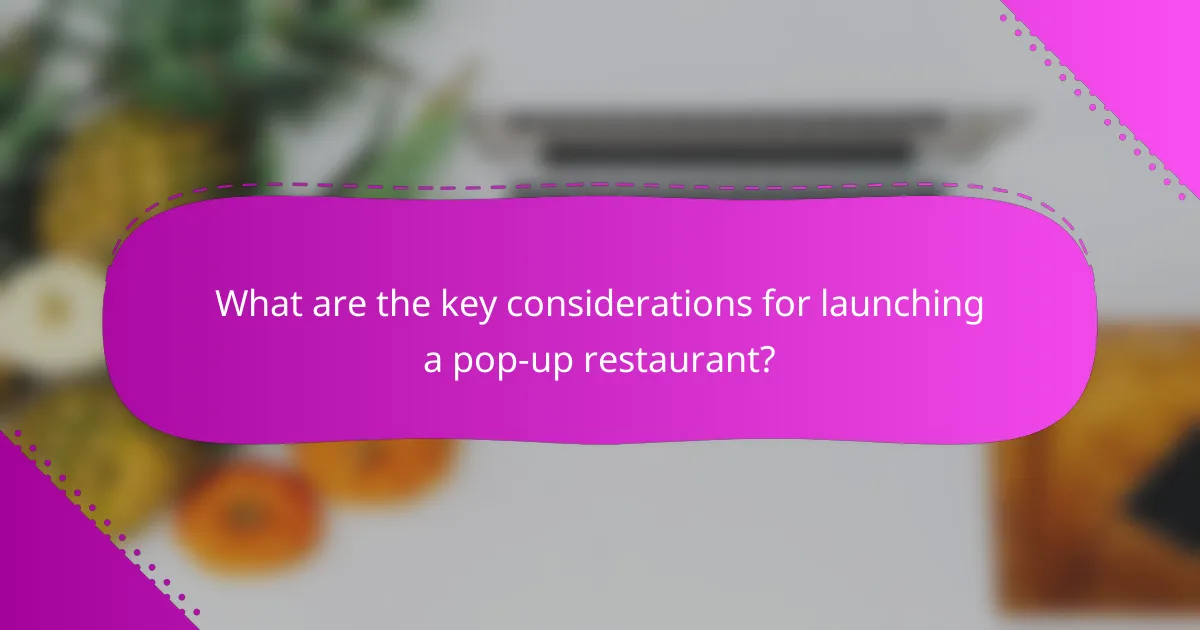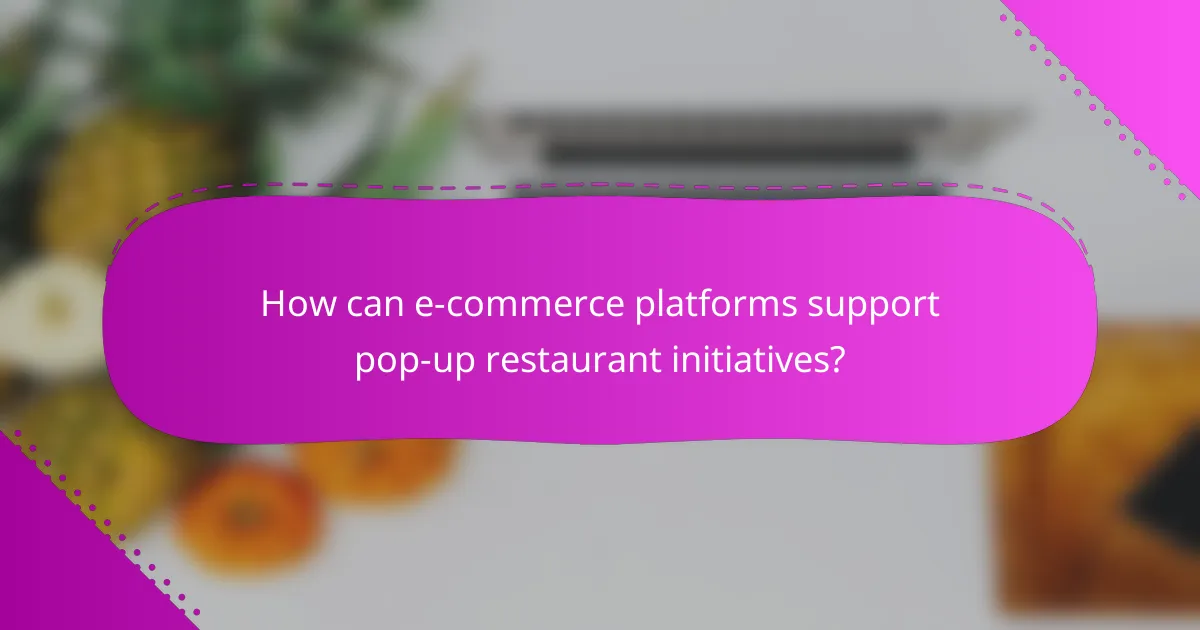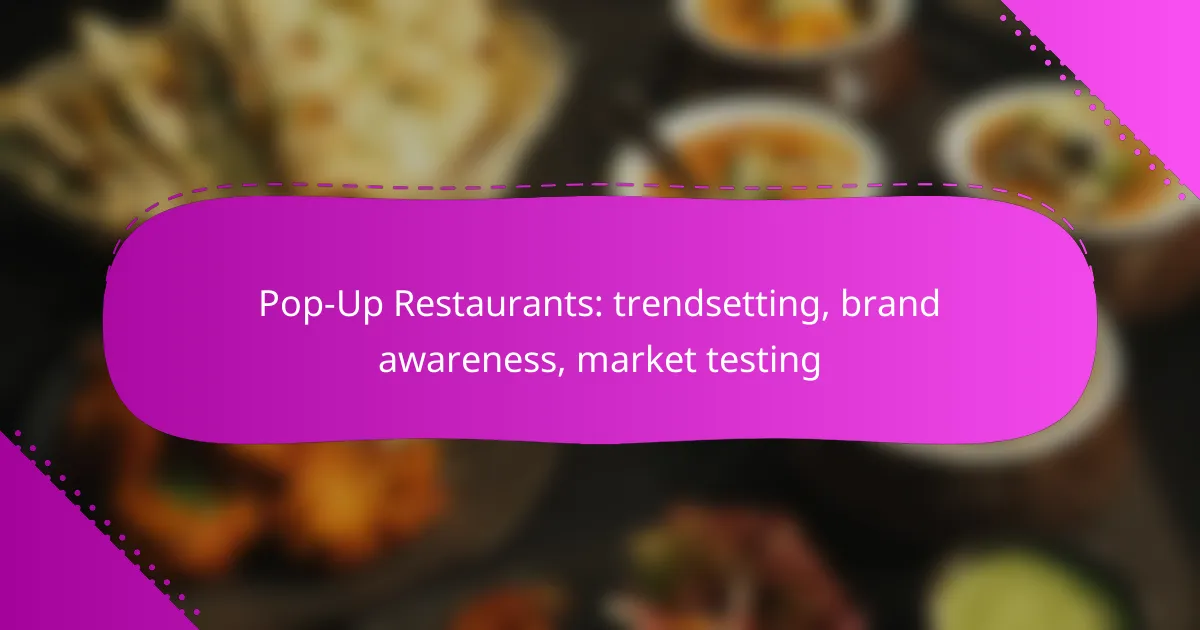Pop-up restaurants have emerged as a dynamic trend in the culinary world, offering brands a unique platform to enhance visibility and engage with customers. By creating memorable dining experiences, these temporary venues not only showcase innovative culinary concepts but also serve as effective market testing grounds, allowing businesses to gather valuable consumer insights and adapt to evolving preferences.

How can pop-up restaurants enhance brand awareness in Canada?
Pop-up restaurants can significantly boost brand awareness in Canada by creating memorable experiences that engage customers and generate buzz. These temporary dining venues allow brands to showcase their culinary offerings while connecting with local communities and testing new concepts.
Engaging local influencers
Partnering with local influencers is a powerful strategy for pop-up restaurants to enhance brand visibility. Influencers can help promote the event through their social media channels, reaching a wider audience and attracting potential customers. Consider inviting food bloggers or local celebrities to your pop-up to create excitement and credibility.
When selecting influencers, look for those whose audience aligns with your target demographic. A well-chosen influencer can amplify your reach and create authentic connections with their followers, leading to increased foot traffic and brand recognition.
Creating unique dining experiences
Unique dining experiences are a hallmark of successful pop-up restaurants. By offering themed menus, interactive cooking sessions, or collaborations with renowned chefs, you can attract attention and encourage social sharing. For example, a pop-up that features a fusion of local ingredients with international cuisine can intrigue food enthusiasts and drive interest.
Ensure that the experience is not only memorable but also aligns with your brand identity. This coherence helps reinforce your brand message and makes it easier for customers to recall your offerings long after the event.
Utilizing social media marketing
Social media marketing is essential for promoting pop-up restaurants and enhancing brand awareness. Platforms like Instagram and Facebook allow you to share visually appealing content, such as photos of dishes and behind-the-scenes glimpses, which can attract attention and encourage engagement. Use targeted ads to reach specific demographics in your area.
Consider creating a unique hashtag for your pop-up event to encourage guests to share their experiences online. This user-generated content can further amplify your brand’s reach and create a sense of community around your dining experience. Regularly engage with your audience by responding to comments and sharing updates to maintain interest and excitement.

What are the benefits of market testing with pop-up restaurants?
Market testing with pop-up restaurants offers unique advantages, such as gaining immediate customer insights and evaluating new concepts in a low-risk environment. This approach allows brands to refine their offerings and better understand consumer preferences before committing to a permanent location.
Gathering customer feedback
Pop-up restaurants provide an excellent platform for gathering direct customer feedback. By engaging with diners in real time, operators can learn about their experiences, preferences, and suggestions for improvement.
Consider using surveys or informal conversations to collect insights. This feedback can guide menu adjustments, service enhancements, and overall customer experience improvements.
Testing new menu items
Testing new menu items in a pop-up setting allows restaurants to gauge customer reactions without the long-term commitment of a full menu change. This method helps identify popular dishes and those that may need refinement.
It’s beneficial to offer a limited selection of new items alongside established favorites. This strategy can help measure customer interest and willingness to pay, providing valuable data for future menu planning.
Assessing location viability
Pop-up restaurants serve as a practical way to assess location viability before investing in a permanent space. By operating in different neighborhoods, businesses can analyze foot traffic, customer demographics, and local competition.
Choosing a high-traffic area for the pop-up can yield insights into potential sales and customer engagement. Tracking sales performance and customer interactions in various locations helps inform future site selection decisions.

How do pop-up restaurants contribute to trendsetting in the food industry?
Pop-up restaurants play a significant role in trendsetting within the food industry by introducing novel culinary experiences and engaging consumers in unique ways. These temporary dining establishments often serve as testing grounds for innovative concepts, allowing chefs and brands to gauge customer interest and adapt quickly to emerging food trends.
Showcasing innovative culinary concepts
Pop-up restaurants provide a platform for chefs to experiment with creative dishes that may not fit into traditional restaurant menus. This flexibility encourages culinary innovation, as chefs can explore new flavors, techniques, and presentation styles without the long-term commitment of a permanent location.
For instance, a pop-up might feature a fusion of international cuisines, such as Korean tacos or sushi burritos, attracting food enthusiasts eager to try something different. This approach not only excites customers but also sets the stage for potential long-term trends in the food market.
Collaborating with local chefs
Collaboration is a key feature of many pop-up restaurants, where established chefs partner with local talent to create unique dining experiences. This not only elevates the culinary offerings but also fosters community engagement and supports local food culture.
For example, a pop-up might invite a renowned chef to work alongside local artisans, resulting in a menu that highlights regional ingredients and flavors. Such collaborations can enhance brand visibility and create buzz, making the pop-up a must-visit destination.
Creating limited-time offers
Limited-time offers are a hallmark of pop-up restaurants, generating urgency and excitement among consumers. By providing exclusive dishes or themed events for a short duration, these establishments encourage patrons to visit before the opportunity disappears.
For example, a pop-up might feature a seasonal menu that showcases autumn ingredients for just a few weeks, enticing customers to experience the menu before it changes. This strategy not only drives foot traffic but also helps restaurants gauge which dishes resonate most with their audience, informing future offerings.

What are the key considerations for launching a pop-up restaurant?
Launching a pop-up restaurant requires careful planning and execution across various aspects, including location, permits, and budgeting. These considerations ensure a successful venture that can enhance brand visibility and test market demand.
Location selection
Choosing the right location is crucial for attracting customers to your pop-up restaurant. Look for high foot traffic areas, such as busy streets, popular markets, or events, where your target audience is likely to gather.
Consider the demographics of the area as well. A location that aligns with your brand’s identity and appeals to your desired customer base can significantly impact your success. Research local competition and trends to identify the best spots.
Permitting and regulations
Before launching, ensure you understand the necessary permits and regulations for operating a pop-up restaurant in your area. This may include health permits, food handling licenses, and local zoning laws.
Contact local authorities to clarify requirements and avoid potential fines or shutdowns. Regulations can vary widely by city or country, so thorough research is essential to ensure compliance.
Budgeting and financing
Establishing a clear budget is vital for the success of your pop-up restaurant. Consider costs such as location rental, permits, staffing, ingredients, and marketing. A well-planned budget helps prevent overspending and ensures you can sustain operations.
Explore financing options, such as personal savings, loans, or crowdfunding, to cover initial expenses. Keep track of your spending and adjust your budget as needed to maintain financial health throughout the pop-up’s duration.

How can e-commerce platforms support pop-up restaurant initiatives?
E-commerce platforms can significantly enhance pop-up restaurant initiatives by providing tools for online reservations, merchandise sales, and delivery integration. These features streamline operations and improve customer engagement, making it easier for pop-up restaurants to attract and retain patrons.
Facilitating online reservations
Online reservations are crucial for pop-up restaurants to manage customer flow and optimize seating arrangements. E-commerce platforms can offer integrated booking systems that allow customers to reserve tables easily, reducing wait times and enhancing the dining experience.
Consider using platforms that provide real-time availability and automated confirmation notifications. This can help minimize no-shows and ensure a smoother operation, allowing the restaurant to focus on food quality and service.
Offering merchandise sales
Pop-up restaurants can boost revenue by selling branded merchandise through e-commerce platforms. This could include items like t-shirts, mugs, or specialty sauces that reflect the restaurant’s theme or cuisine.
Utilizing an e-commerce platform for merchandise sales allows for easy inventory management and customer transactions. Offering limited-edition items can create urgency and encourage customers to purchase while they visit.
Integrating delivery options
Integrating delivery options is essential for pop-up restaurants to reach a broader audience. E-commerce platforms can facilitate partnerships with delivery services, allowing customers to enjoy meals at home.
When selecting delivery options, consider factors such as delivery fees and timing. Offering a range of delivery methods, from standard to express, can cater to different customer preferences and increase overall sales.

What are successful examples of pop-up restaurants in Canada?
Successful pop-up restaurants in Canada often showcase innovative concepts and unique culinary experiences, allowing chefs to test new ideas and build brand awareness. These temporary dining establishments can create buzz and attract a diverse clientele, often leading to permanent locations or collaborations.
Notable pop-up restaurant concepts in Canada
Several pop-up restaurants have gained attention in Canada for their creative themes and culinary offerings. For instance, the Food Truck Festival in Toronto features various food trucks that operate as pop-ups, allowing chefs to reach new audiences without the overhead of a traditional restaurant. Another example is Le Burger Week, where restaurants across the country create unique burger recipes available for a limited time.
Key considerations for launching a pop-up restaurant
When launching a pop-up restaurant, it’s essential to consider location, target audience, and marketing strategies. Choose a high-traffic area to maximize visibility and foot traffic. Engaging with local communities through social media and collaborations can help generate interest and attract customers.
Benefits of pop-up restaurants for brand awareness
Pop-up restaurants serve as an effective tool for building brand awareness. They allow businesses to showcase their culinary talents and unique concepts in a low-risk environment. By creating a sense of urgency with limited-time offerings, pop-ups can encourage customers to visit and share their experiences, amplifying word-of-mouth marketing.
Challenges faced by pop-up restaurants
Despite their advantages, pop-up restaurants face several challenges. Limited timeframes can lead to logistical issues, such as sourcing ingredients and managing staff. Additionally, the transient nature of pop-ups may hinder customer loyalty, making it crucial to create memorable experiences that encourage repeat visits.
